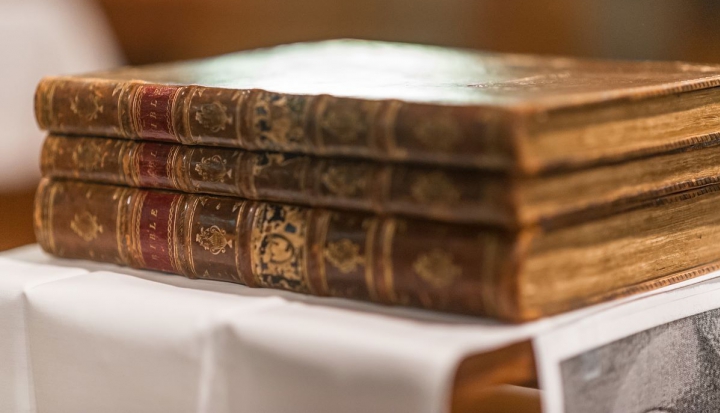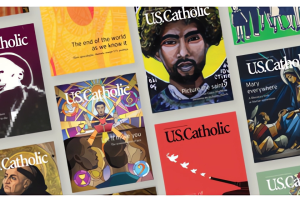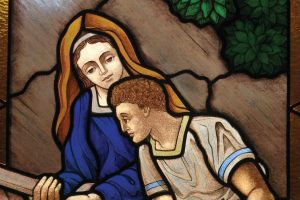Alert: history nerds!
More than two hundred years ago, Father Stephen Badin, the first priest ordained in this young nation, took a Bible with him on his journey from Baltimore to the Kentucky frontier, where he would begin his ministry. It was an ordination gift from John Carroll, the bishop who ordained him, and it contained Carroll’s affectionate inscription. Little could Badin imagine that in 2014 the University of Notre Dame would convene a symposium—with no less than four history professors speaking—to discuss the historical significance of this very Bible.
This past summer Notre Dame officially welcomed the Bible that belonged to Father Badin, the first priest ordained in the United States, who once owned the Indiana land on which Notre Dame now stands. Father Badin is buried in the historic Log Chapel on campus.
Notre Dame bought the Bible from the Sisters of Loretto of Nerinx, Kentucky, who in July handed it over personally during Mass in the Log Chapel.
Badin, the first priest ordained in the United States, fled France in 1790 as a young seminarian during the French Revolution and the Reign of Terror. After finishing his studies in Baltimore, he was ordained in 1793 by Bishop John Carroll, the first bishop of the United States. Carroll presented Badin with this three-volume set of the Douay-Rheims Bible, inscribed, “To the Reverend Stephen Badin from his affectionate bishop John Carroll of Baltimore.”
Badin was sent to the frontier of Kentucky, where he built up the local church in the Ohio valley. The Loretto Motherhouse stands on the land where he lived; in fact, several Loretto Sisters today still live in Badin’s small brick house. When he departed Kentucky in 1819, eventually ending up in Indiana, Badin left the Bible behind him. It made its way to the Sisters of Loretto, who, as their archivist Sister Eleanor Craig proudly told me, “rose up from the Kentucky frontier” in 1812 and have lived and worked there ever since. (The Sisters, founded by three pioneer women who had moved to Kentucky from Maryland after the Revolutionary War, were the first community of religious women that sprang up in the U.S. on its own, rather than being an outgrowth of a European community with European traditions.)
When Badin was not able to begin the boys’ school he had hoped to establish in what is today South Bend, he passed the land on to the Holy Cross Fathers, and the rest is history.
The Bible itself is significant beyond the fact that it belonged to the first U.S. priest and is inscribed by the first U.S. bishop. These three volumes constitute the rarest Bible in the country: Only 26 are known to exist, out of fewer than 500 that were printed in 1790. It was the first Douay or “Catholic” Bible printed in the Americas; Catholics at the time numbered only about 35,000 of the country’s 4 million inhabitants, or just 1 percent. It was published by Matthew Carey, an Irish immigrant journalist, publisher, and printer who had once apprenticed with Ben Franklin.
Notre Dame Magazine passes on a quote from Kathleen Sprows Cummings, director of the Cushwa Center for American Catholicism, that puts the Bible in perspective: “Inscribed by a Catholic bishop, owned by a Catholic priest and a religious congregation, published by a lay leader, received on the feast of a lay woman, this Bible knits together the priestly, religious and lay vocations within the Church, all collaborating in the vineyard of the Lord,” she said in July after the Mass during which the book was handed over. “And surely that is something worth celebrating.”
The Sisters of Loretto diplomatically report that they sold the Bible to Notre Dame for “a significant sum.” They also note that the negotiations went on for six months. I trust the Sisters drove a hard bargain.
The Bible, which had been lovingly preserved by the Sisters but was not available to be admired or studied (in recent decades it lay in a climate-controlled vault beneath their infirmary and was rediscovered by a volunteer cataloguing the Sisters’ rare books), is on display in the Rare Books and Special Collections Room on the main floor of Notre Dame’s Hesburgh Library during the fall semester. And this Friday, October 10, it will be the star of the show at the Badin Bible Symposium at Notre Dame.
For more, check out the photos from the Loretto Sisters’ July ceremony bidding farewell to the historic Bible.
Photo courtesy of the Cushwa Center for the Study of American Catholicism, University of Notre Dame











